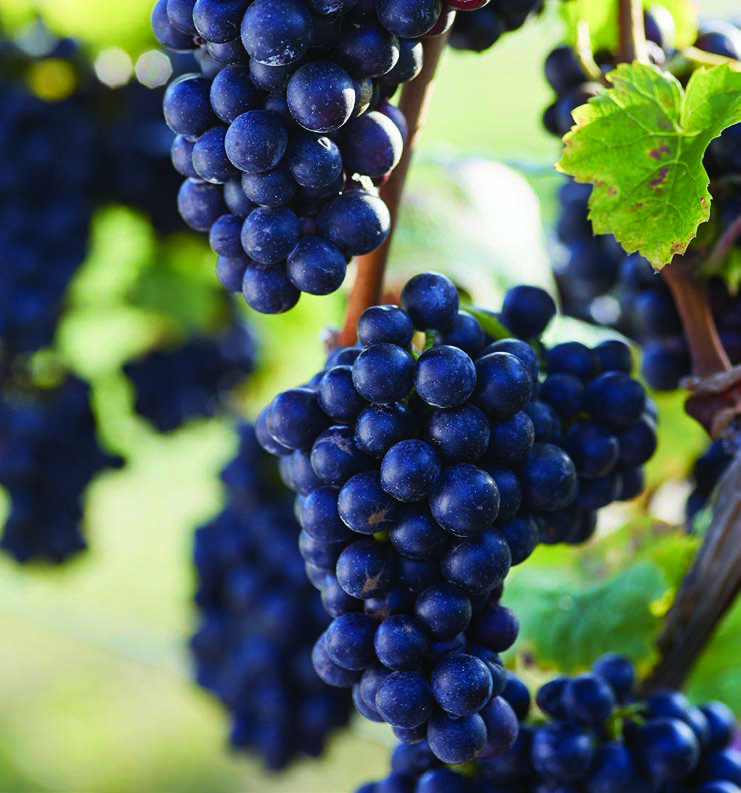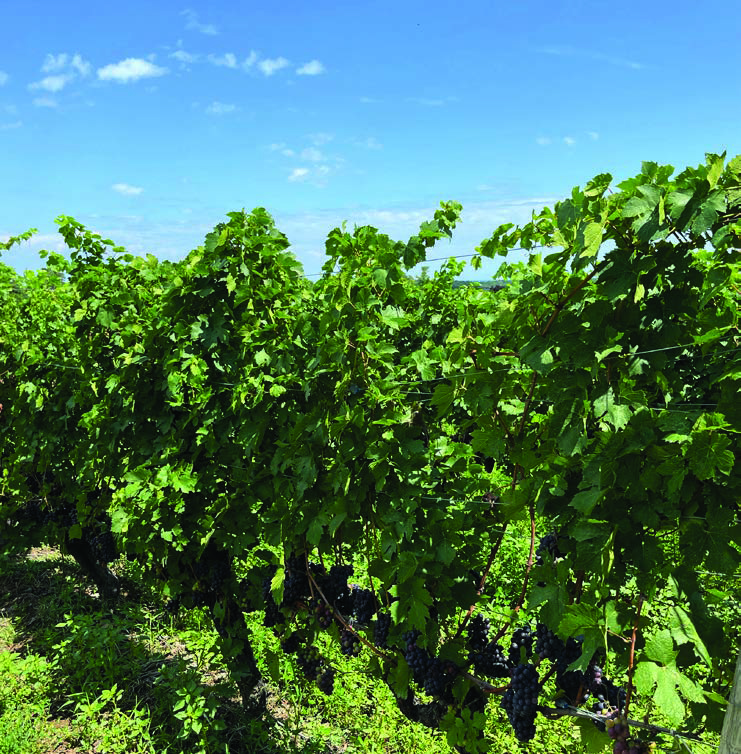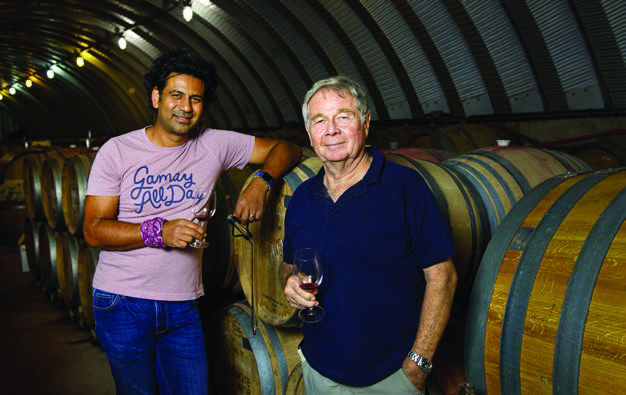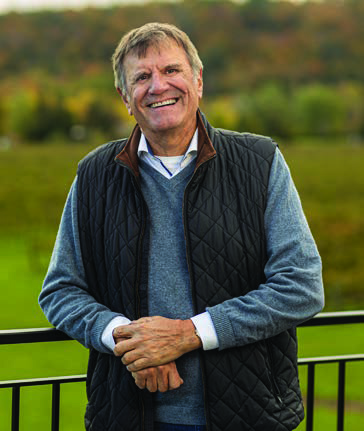This article originally appeared in the Fall/Winter 2022-2023 print issue of Quench Magazine.
Janet Dorozynski coined the hashtag #gogamaygo in 2012 as a rallying cry for Gamay in Canada and globally. After tasting several dozen Gamay from Ontario, she remains bullish about its future in the region.
Earlier this year I tasted through Thomas Bachelder’s latest offerings of Ontario Gamay – seven single varietal Gamay, and a passe-tout-grain-style from the 2020 vintage.
The number of Gamay made by one winery struck me. When I started looking around and saw that Malivoire was making an equally impressive seven single varietal Gamay, and 13th Street was making four, including a traditional method sparkling Gamay, I was intrigued to investigate further the current Gamay state of mind in Ontario.
While Bachelder admits it has become more difficult to get all the Pinot Noir he would like, his interest in Gamay predates the recent releases. He remembers sourcing Chardonnay in the southern Mâconnais to ferment in Nuits St. Georges for his Bachelder Burgundy project, while his northern Burgundian colleagues were sourcing Côte de Brouilly and southern Mâconnais Gamay to vinify in the Côte de Nuits.
Bachelder wondered at the time why he was not doing this in Niagara, since, like Burgundy, there was not enough Pinot Noir planted in Ontario to satisfy demand. He is doing just that now, and as “a pilgrim on the road to Gamay,” believes that “Gamay Noir is immediately understandable and forever unknowable”.
THE HISTORY OF GAMAY IN ONTARIO
Gamay has an important place in Ontario’s wine and viticulture history, and a longstanding commitment to the variety by wineries like Inniskillin, Cave Spring and Château des Charmes. It was one of the earlier planted vinifera, with records of commercial plantings dating back to the early 1970s. Karl Kaiser and Donald Ziraldo were early supporters of the variety, and their first Liquor Control Board of Ontario (LCBO) order in 1975, after Inniskillin was granted the first winery licence in 1974, was for 500 gallons of Gamay Noir. Then, as now, Gamay is well suited to Ontario’s climate and growing season – short, warm to hot, fairly humid, and followed by cold winters. Gamay is cold hardy, even more so than its Burgundian cousins Chardonnay and Pinot Noir, the latter of which is later ripening, lower yielding and overall quite finicky.
Ontario even has its own clone of Gamay, “droit,” which was discovered at Château des Charmes in the early 1980s and propagated at the winery vineyard ever since. Owner Paul Bosc Sr. discovered the clone after seeing certain Gamay vines that grew straight up (“droit”) and taller than the rest of the vineyard. The wines they produced were more complex, and after genetic testing, a specific and unique clone of Gamay was identified.

Château des Charmes was granted International Plant Breeders’ Rights and is the only producer that can grow the Gamay Noir “Droit” clone.
Other early adopters of Gamay are 13th Street and Malivoire. I have very fond memories of tasting earlier vintages of the 13th Sandstone Gamay and being impressed by the depth, beauty, and Cru Beaujolais-like quality of these wines that were like nothing I had tasted before in Ontario. Malivoire, first planted Ga-may in 1998 to make rosé, but little did they or anyone else know that the guiding hand, first of Ann Sperling and now Shiraz Mottiar, would take Gamay to the heights of transcendence on the Beamsville Bench. GM Stephen Gash says it’s important that each of their seven Gamays are individual and “that each bottle offers a dis-tinct voice while being varietally true and true to site(s) and intention.” They currently have 23 acres planted of Gamay with the variety being the key focus of any future red plantings.
GAMAY IN ONTARIO: “IT’S TOUGH” AND “IT GROWS”
Ontario has the most vineyard space devoted to Gamay outside of Beaujolais and then Switzerland. While exact acreage is impossible to come by for Ontario, latest data from the Ontario Wine Appellation Authority shows that thirty-nine wineries made 68 single varietal Gamay wines in 2022, compared to 20 wineries and 26 wines in 2011. Production of single varietal Gamay has increased from 177,618 to 238,190 litres between 2011 and 2022, with a high of 427,518 litres in 2021. The total production of Gamay used in all VQA wines in Ontario has almost doubled between 2011 and 2022, climbing from 443,818 to 784,940 litres. Long story short, while the number of wineries and production of Gamay has increased, a significant volume of Gamay finds its way into blended rather than single varietal wines. In terms of Ontario VQA production, Gamay represents 3% of the total volume, while Cabernet Franc and Merlot are at 11% and Pinot Noir at 6%.
Most Ontario Gamay is grown in Niagara, with a smattering in Lake Erie North Shore and Prince Edward County. Colio Estates and Pelee Island have been making Gamay in Lake Erie North Shore since the 1990s. There are also respectable examples of Gamay in Prince Edward County from Casa-Dea, earlier vintages from the Grange, and from newcomer Broken Stone, who make an oaked and unoaked Gamay from County fruit.
Gamay ripens early and consistently, which makes it well-suited to Ontario’s shorter growing season. The vine is also vigorous and tends to overproduce (and is more susceptible to powdery mildew than other Burgundy varieties) which according to Harald Thiel, proprietor of Hidden Bench, “needs thinning to yield quality.” Hidden Bench planted Gamay in 2016 and Thiel believes that depending on the style, Gamay can be “an easy drinking red that provides good value to consumers” or a “serious Cru style cellar worthy wine.”
He considers that Gamay, like Cabernet Franc, has potential for a “cost effective red wine alternative” since the “viticulture costs/quality ratio is more effective.” That said, Thiel and Hidden Bench remain very committed to Pinot Noir as their primary red grape.
In addition to early and consistent ripening, the variety is very cold hardy. Tom Pennachetti of Cave Spring Cellars, who first planted five acres of Gamay on the Beamsville Bench in 1984, describes Gamay as “in a word, it grows.” Jim Wilwerth, assistant professor of Biological Sciences and researcher at Brock University’s Cool Climate Oenology and Viticulture Institute (CCOVI), concurs. Wilwerth notes that CCOVI has “tested many cultivars in Ontario, from core ones to very uncommon, and Gamay is one of the hardiest vinifera” and that it’s “one of the most resilient cultivars we grow – it’s tough.” Grape grower Craig Wismer also attests to the cold hardiness of the variety. He explains that while there was a fair amount of dormant bud and vine damage in winter 2021/2022 across the 300 plus sites that the Wismer family farms for themselves and others, “Gamay Noir came through as the hardiest…. especially on the Vineland Bench where we had a 95+ survival rate in the Wismer-Fox-croft vineyard.”

Winemaker Shiraz Mottiar and Martin Malivoire of Malivoire 
Len Pennachetti, president & co-founder of Cave Spring Cellars
MAKING AND TASTING ONTARIO GAMAY
Many Ontario producers vinify Gamay like Pinot Noir: destemmed, cold soaked and regular punch downs during fermentation. There are a growing number using semi-carbonic maceration, with percentages of whole clusters varying from five to 100%. Many use stainless steel and neutral barrels, while some employ concrete fermenters. Oak treatment also varies, with some producers unfortunately still using too much new oak that smothers the bright fruit and flavours of the variety.
Though difficult to generalize, I think Ontario wineries are getting a handle on the vineyards and sub-appellations where Gamay does well. We see great and diverse examples from Lincoln Lakeshore, Vinemount Ridge, Four Mile Creek and the Beamsville and Twenty Mile Benches. After tasting dozens of Gamay my takeaway is that Gamay from the flatter, hotter Niagara-on-the-Lake sub-appellations tend to be more perfumed with juicy acidity and red fruit, while Bench Gamay leans to darker fruit, firmer acidity and tannins with less floral and spice notes.
GAMAY CRYSTAL BALL GAZING
I remember a discussion ten plus years ago with a Niagara winery who pulled out their Gamay vines because they found it too difficult to sell, only to replant
it again. I think one of the reasons why Gamay has been a hard sell in Ontario is because consumers do not have a clear idea of what the variety is, or if they do, have an association with Beaujolais Nouveau, which has done little to pique consumer interest, nor highlight Gamay as a quality variety.
The tide, however, seems to be turning and not just because Cru Beaujolais is having a moment. Cave Spring’s Pennachetti believes the tannin and acid structure of Gamay makes for “a succulent style of wine that meets the demand among younger restaurant buyers and consumers,” and the bold, complex flavour profile matches “beautifully with contemporary food trends incorporating South American, Middle Eastern and South Asian dishes.” When I asked Pennachetti about his outlook for Gamay in Ontario, his response was unequivocal: “actions speak louder than words….over the past dozen years we have more than plans to return to making their estate Ga-may again, and will release their first tradition-al method rosé brut made from 100% Gamay.
I remain bullish about the future of Gamay in Ontario. While Pinot Noir and Cabernet Franc do well, Gamay is an undeniably worthy variety that offers good value – most are priced between $15 and $30 – spanning the gamut from bright and light to concentrated and complex, with just enough seriousness to keep them interesting.

Bachelder ‘Bai Xu Single Vineyard’ Gamay Noir 2020, VQA Four Mile Creek
One of Bachelder’s seven Gamay and the most compelling in my opinion. From the Bai Xu vineyard planted in 1981, the combination of old vines and 32% whole cluster bolster and benefit this complex and intense wine. Vivid perfumed aromas and flavours of black raspberries and dark cherries with a savoury mid-palate. Aged in neutral oak barrels. Medium bodied with rounded tannins and a salivation provoking acidity. Very long dark berry finish. 13% abv.
Brokenstone ‘Unoaked’ Gamay Noir 2021, VQA Prince Edward County
Intensely fragrant nose of raspberries and cream and cinnamon spice toast. The palate displays slightly more tart fruit, think cranberry and sour cherries that are equally pleasing. Medium bodied with juicy acidity and silky smooth tannins. Very long red berry compote finish and oh-so-charming. Long live County Gamay. 12% abv.
Château des Charmes Gamay Noir 2019, VQA Niagara-on-the-Lake
One of Niagara’s OG Gamay producers with vineyards dating back to the late 1970s. This unoaked Gamay made from estate-grown fruit is a consistently good and good value wine and this vintage might be the best to date. Spice and sour cherry and cranberry aromas and flavours with delicate fine tannins and crisp juicy acidity. Medium long finish. Château des Charmes also makes a Gamay “droit” worth checking out as well. 12.5% abv.
Flatrock Cellars ‘Explore Project No. 9’ Gamay 2019, VQA Niagara Peninsula
This is Flatrock’s first foray into the Gamay grape and an impressive effort at that! Medium intense nose and palate of cherries, cranberries and some cinnamon spice. Dry, with juicy acidity and slightly chalky tannins. The lighter side of medium bodied with a long, dried cherry finish. 11.5% abv.
Hidden Bench Gamay ‘Unfiltered’ 2020, VQA Lincoln Lakeshore
A polished juicy Gamay with intense red berry fruit aromas and flavours along with a hint of spice and savouriness. Medium bodied and well structured with rounded tannins. Good concentration and length. 12.5% abv.
Leaning Post Gamay 2019, VQA Twenty Mile Bench
Dark cherry and blackberries on the nose and palate with a lovely savoury spice character with floral notes. Dry and medium bodied with good concentration and structure. The dark and red berry finish is long and succulent. 12% abv.
Malivoire ‘Le Coeur’ Gamay 2021, VQA Beamsville Bench
Malivoire first planted Gamay in 1998 with the intention to make rosé. Fast forward several decades and they have become Niagara’s and Ontario’s flagbearer for delectable Gamay. The “Coeur” is 100% whole cluster made using semi carbonic maceration, which yields a complex yet fresh red with silky ripe tannins and juicy acidity. A bushel of red and black berries and fruits mingle with spice and tea notes on the palate and long finish. 12.5% abv.
Southbrook ‘Whimsy Clone 358’ Gamay 2020, VQA Vinemount Ridge
From the Vinemount vineyard of wine growing wizard Heather Laundry, this fresh and juicy medium-bodied Gamay radiates intense red berries and spice on the nose and palate. Delicate powdery tannins with very good concentration. One-third whole cluster. A long and pleasing finish of red and black berries with dried herb notes. Certified organic. 13% abv.
Stratus Gamay 2020, VQA Niagara-on-the-Lake
For fans of bigger, bolder styles of Gamay. Blackberry, spice and mocha notes on a fuller medium bodied frame. Dry and concentrated, the acid is slightly tart and there is a fair bit of tannin, which is ripe and will no doubt resolve in time. I would age this for several years or decant it if you plan on drinking it now. 13.8% abv.
Tawse ‘Cherry Avenue Vineyard’ Gamay Noir 2019, VQA Twenty Mile Bench
From Tawse’s first estate planting of Gamay dating back to 2014. Quite a silky and textured wine with red and black cherry aromas and flavours with hints of tea and spice. Medium bodied with rounded tannins and juicy acid. Long spicy ripe cherry finish. Aged 20% in new oak. 11.5% abv
13th Street Gamay 2020, VQA Niagara Peninsula
13th Street makes three varietal Gamay as well as a vin gris and traditional method sparkling from Gamay. This is their unoaked version, which has a purity of red and black cherry fruit and I find to be their best. Medium bodied with lively acidity and soft tannins. The palate is juicy with good concentration and a medium long finish. 13% abv.
Janet Dorozynski left life as an academic and has been tasting, judging, teaching & communicating about wine, beer and spirits from across Canada and the world for more than twenty years. She holds the WSET Diploma, a PhD from Concordia University and is a WSET Certified Educator.


